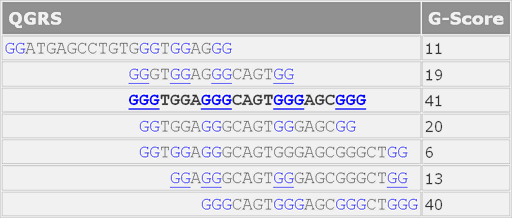
 |
|
QGRS Mapper Help: Dealing with overlaps
Two QGRS are said to overlap if their positions in the nucleotide sequence overlap. Overlapping G-quadruplexes may differ in total length, loop sizes and loop sequences. These sequence arrangements have the potential to form intramolecular quadruplexes in the cell, many of which may be stable.
In order to focus our studies on an unambiguous sequence, we have used a scoring system which rewards an arrangement that is likely to form an intramolecular quadruplex (see the section Understanding G-Scores for more details). QGRS Mapper will start with a nucleotide sequence, find all QGRS occurring in the sequence and then produce a non-overlapping set of QGRS. Overlaps are eliminated by selecting the higher scoring QGRS.
Example 1: The following table shows a small sample of the 24676 overlaps found in the human GREB1 gene. The first sequence starts at position 40356 in intron 4 of the gene.

From the indicated overlapping sequences the program selects the bolded sequence, i.e., the highest scoring one.
In the non-overlapping view, only this sequence will be displayed, although the user can request that all overlapping sequences be displayed.
Example 2: 8729GGGGGAGAGGACAGGGAGGAGGGATTGG8756
Mapped near alternative splice site of the Mouse Guanylyl Cyclase-B (Npr2) gene (NCBI Accession # AH013048), the above sequence can theoretically form 173 overlapping G-quadruplexes.
Some (out of 173) potential overlapping arrangements from the above example:

A highest scoring QGRS, designated as "non-overlapping" is selected (# 5 in the above example) out of all the possible arrangements.
Unless specifically mentioned, all further data analysis is performed on non-overlapping QGRS.
 |
|


| |